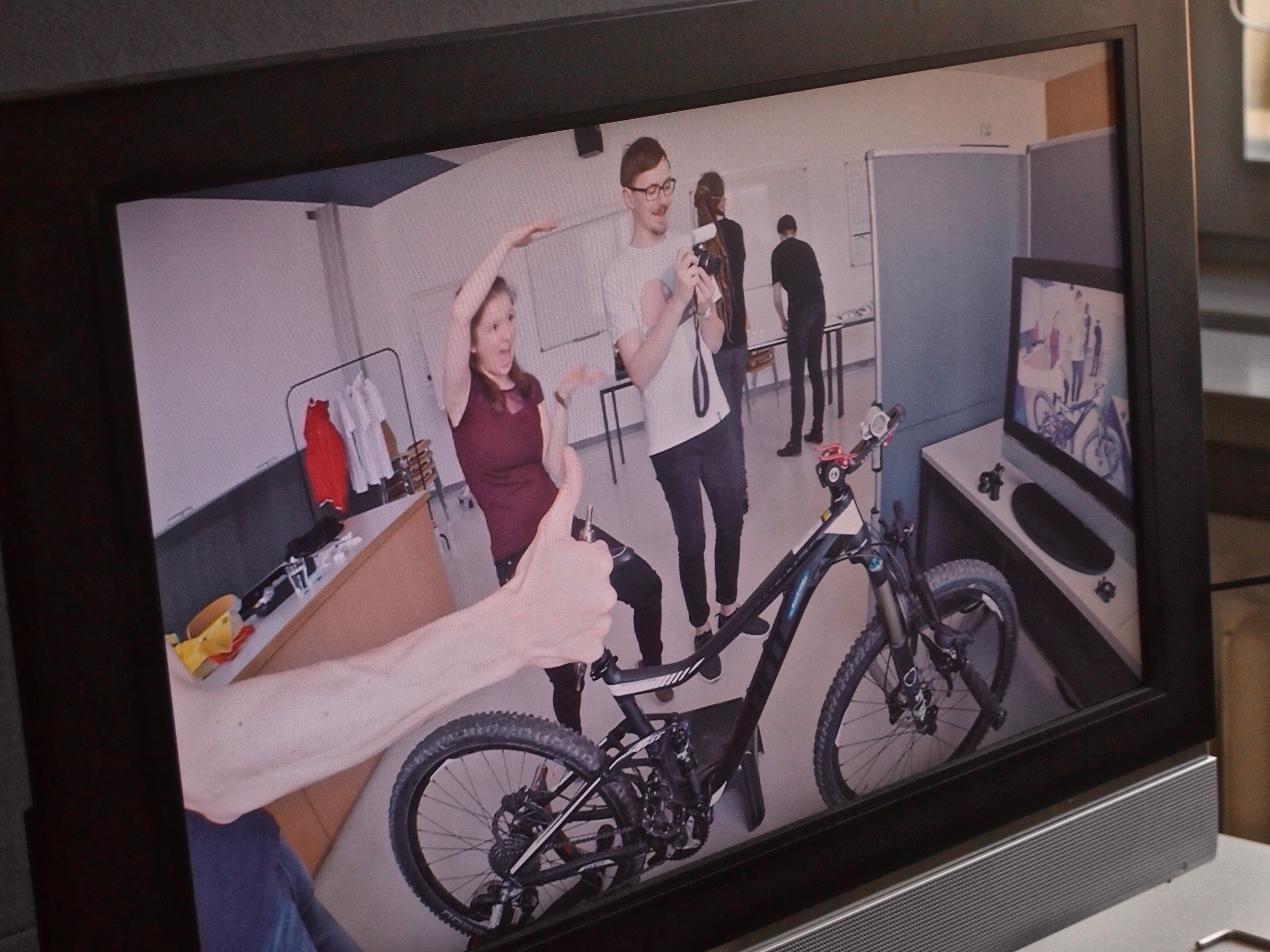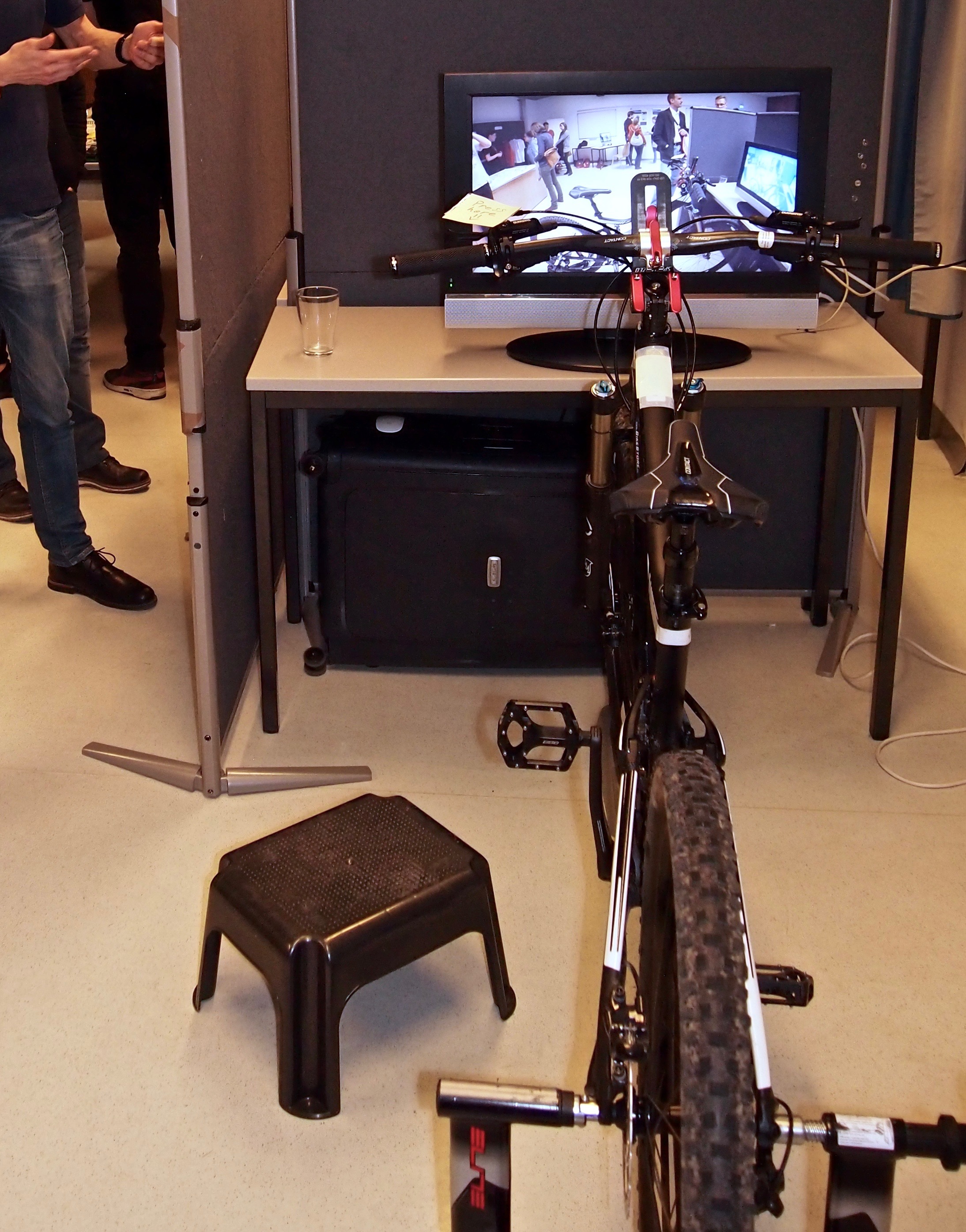by Robin Rae
“And what can I do here?” people ask me curiously one after another, eyeballing a mountain bike standing upright in front of a computer screen. I am in the lecture room of the Department for Science and Technology Studies (STS), University of Vienna, which is filled with people, technological objects, and further installations about RFID chips, artificial intelligence, and visions of reproductive medicine and self-driving cars. It is a Friday night in April 2016, the so-called “Lange Nacht der Forschung” (i.e. Long Night of Research). This nation-wide biannual science communication event invites diverse publics to interactively explore current research at more than 250 institutions. With its interactive installations, the STS department aimed to spark discussions about how technologies affect and shape society, bodies, everyday lives, and futures. While that only partially explains the bike standing in the room, read on to learn how challenges in planning my installation contributed to its realization.
The above introductory question was a common first step for visitors to get into dialogue and interaction with my research, thus into public engagement with science by two-way communication (Wooden 2006). In my PhD project I utilize a comparative case study on mountain bikes to investigate how technological changes in outdoor-sports irritate and enable relations of human-technology-environment, and how these are negotiable. I decided to include the bike as an object to interact with to fulfill the premise of dialogue and mutual learning in public engagement with science (Stilgoe and Lock 2014) in a fun yet meaningful way. While this promising outlook and implied symmetry grabbed my interest from the get go, I first needed to construct and order materials that stimulate such engagement. Doing so, I encountered some peculiarities preparing my two-sided installation that should address both the material and imaginative dimension of how human, bike, and environment are aligned meaningfully.
On one side visitors could explore different combinations of human-bike-environment by flipping through a tripartite booklet containing pictures of different riding environments, bicycles, and riders in specific clothing. The idea was to animate visitors to reflect how one can identify with cycling technology and practices, and how imaginations of future rides partake therein. Creating this leaflet, though, posed several challenges: How would images speak to a wide audience? How could I enable a broad scope of interpretation and imagination? And in how far would the artefact speak for itself?
Inspired by discussions with dear colleagues from the STS department, the booklet also included non-sportive, urban, and lifestyle depictions to widen its scope. To stimulate ordering work of visitors it was of great importance to provide dis-order within the booklet, without providing any ‘correct’ combinations. This entailed ordering pictures in dis-order, and making that intention explicit by formulating an accompanying sheet.
On the other side stood the bike to simulate a site of my research, so-called bike fitting: a process of establishing a comfortable yet efficient position with a specialist and tools like cameras, sensors, and displays, while pedaling. I intended to set up a stationary yet adjustable bike on which visitors could experience how bike changes can be felt and valued through the body to further fine-tune that setup, by experimenting with saddle height via a hydraulic seat-post (think hydraulic office chair), and the position of the handlebar via a tool operated by me. Additionally, a small (but visible) camera placed on the side streamed on a display in front of the rider, offering a new perspective on one’s position.
Challenges in realizing this idea started with simple but essential issues that would include or exclude visitors: What size of bike would fit most people? How should the frame be shaped to leave room for adjustments? Would the whole elevated apparatus be too high for some or could people of different size, age, and gender swing a leg over it? Ironically, with my research being about effects of technological change, the compatibility of new and old technology posed a serious threat for the undertaking. Namely, would the rental bike with current axle standards be compatible with the clamping mechanism of the old rollers (in which the rear wheel spins) that I provided? If not, the setup would either not be stable enough to hold a bike plus rider, or not clamp at all.
Long story short, all worked out well. However, a mundane artefact strongly contributed to having everyone who wanted to hop on and pedal: a simple step tread. It allowed kids or shorter adults to get up on the bike, and provided a stable platform for getting on and off it. Thus, the step tread literally created a low-threshold of (material) participation. The resulting dialogues during the evening exceeded my expectations of mutual learning. What struck me most was the immediate effect of discussions on following ones. Thereby I could bring my points across more precisely, and realized that the bike fitting setup itself was about mutual learning. Remembering that fitting-specialists always asked riders how adjustments feel, which resulted in more articulate responses, I emphasized the learning process and asked for changes. Visitors indeed learned to articulate and demand finer adjustments of the setup through engaging materially and discursively. What I could offer and experience as an STS scholar then was a brief opportunity of learning to be affected by differences of the material setup (Latour 2004), of developing a sensitive body and recognizing layers of difference. Hence, that was only possible by differences visitors provided by engaging in their own ways with this socio-material setting, contributing to it more than they might have been aware of.
.
References
Latour, B. (2004). How to Talk About the Body? The Normative Dimension of Science Studies. Body & Society, 10(2-3), 205-229.
Stilgoe, J., & Lock, S. J. (2014). Why should we promote public engagement with science? Public Understanding of Science, 23(1), 4-15.
Wooden, R. (2006). The Principles of Public Engagement: At the Nexus of Science, Public Policy Influence, and Citizen Education. Social Research, 73(3), 1057-1063.
Robin Rae is a PhD scholar at the Department of Science and Technology Studies, University of Vienna. His current main research interests are socio-technical negotiations in sports environments, and collective valuing practices.


